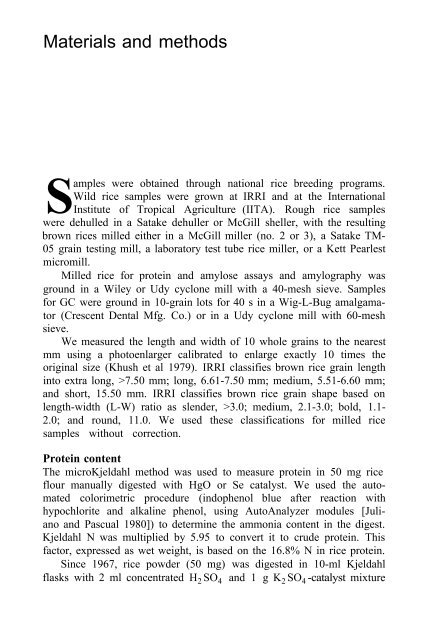Juliano et al. - 1993 - Grain Quality Evaluation of World Rices
Juliano et al. - 1993 - Grain Quality Evaluation of World Rices
Juliano et al. - 1993 - Grain Quality Evaluation of World Rices
You also want an ePaper? Increase the reach of your titles
YUMPU automatically turns print PDFs into web optimized ePapers that Google loves.
Materi<strong>al</strong>s and m<strong>et</strong>hods<br />
S<br />
amples were obtained through nation<strong>al</strong> rice breeding programs.<br />
Wild rice samples were grown at IRRI and at the Internation<strong>al</strong><br />
Institute <strong>of</strong> Tropic<strong>al</strong> Agriculture (IITA). Rough rice samples<br />
were dehulled in a Satake dehuller or McGill sheller, with the resulting<br />
brown rices milled either in a McGill miller (no. 2 or 3), a Satake TM-<br />
05 grain testing mill, a laboratory test tube rice miller, or a K<strong>et</strong>t Pearlest<br />
micromill.<br />
Milled rice for protein and amylose assays and amylography was<br />
ground in a Wiley or Udy cyclone mill with a 40-mesh sieve. Samples<br />
for GC were ground in 10-grain lots for 40 s in a Wig-L-Bug am<strong>al</strong>gamator<br />
(Crescent Dent<strong>al</strong> Mfg. Co.) or in a Udy cyclone mill with 60-mesh<br />
sieve.<br />
We measured the length and width <strong>of</strong> 10 whole grains to the nearest<br />
mm using a photoenlarger c<strong>al</strong>ibrated to enlarge exactly 10 times the<br />
origin<strong>al</strong> size (Khush <strong>et</strong> <strong>al</strong> 1979). IRRI classifies brown rice grain length<br />
into extra long, >7.50 mm; long, 6.61-7.50 mm; medium, 5.51-6.60 mm;<br />
and short, 15.50 mm. IRRI classifies brown rice grain shape based on<br />
length-width (L-W) ratio as slender, >3.0; medium, 2.1-3.0; bold, 1.1-<br />
2.0; and round, 11.0. We used these classifications for milled rice<br />
samples without correction.<br />
Protein content<br />
The microKjeldahl m<strong>et</strong>hod was used to measure protein in 50 mg rice<br />
flour manu<strong>al</strong>ly digested with HgO or Se cat<strong>al</strong>yst. We used the automated<br />
colorim<strong>et</strong>ric procedure (indophenol blue after reaction with<br />
hypochlorite and <strong>al</strong>k<strong>al</strong>ine phenol, using AutoAn<strong>al</strong>yzer modules [<strong>Juliano</strong><br />
and Pascu<strong>al</strong> 1980]) to d<strong>et</strong>ermine the ammonia content in the digest.<br />
Kjeldahl N was multiplied by 5.95 to convert it to crude protein. This<br />
factor, expressed as w<strong>et</strong> weight, is based on the 16.8% N in rice protein.<br />
Since 1967, rice powder (50 mg) was digested in 10-ml Kjeldahl<br />
flasks with 2 ml concentrated H 2 SO 4 and 1 g K 2 SO 4 -cat<strong>al</strong>yst mixture

















